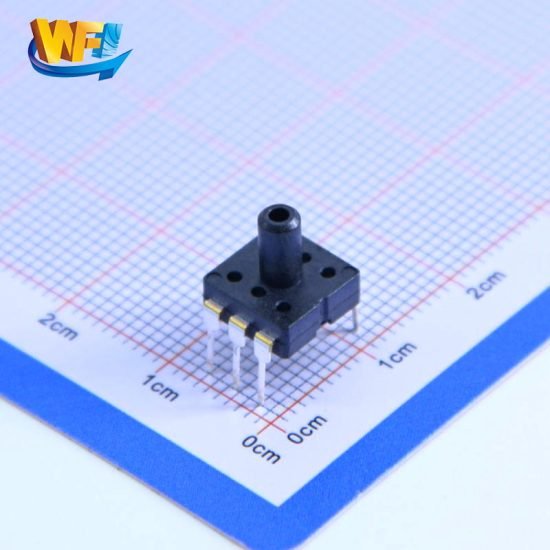Katalog
Semiconductor pressure sensors represent breakthrough in modern sensing technology, providing ideal pressure detection solutions for compact devices through silicon semiconductor properties and MEMS microfabrication technology.
1. Core Advantages of Semiconductor Pressure Sensors
1.1 Miniaturization Design Implementation
Semiconductor pressure sensors achieve miniaturization levels unattainable by traditional mechanical sensors through MEMS technology manufacturing pressure-sensitive elements on single-crystal silicon wafers. Standard DIP packaging design enables direct PCB soldering, occupying only one-tenth the space of traditional pressure sensors.
1.2 Precision Measurement Performance
Semiconductor strain gauge technology ensures precise measurement capabilities with linearity achieving ±0.5% full-scale accuracy. Sensors utilize constant current drive mode with rated driving current of 1.5mA, output span voltage of 100±40mV, and offset voltage controlled within ±20mV.
1.3 Diverse Pressure Range Coverage
The sensor product line covers 10 different specifications from micro-pressure 4.9kPa to high-pressure 980.7kPa, meeting various application requirements. Each specification undergoes precise calibration ensuring optimal measurement accuracy and stability within respective pressure ranges.

2. Key Technical Features and Performance Parameters
2.1 Semiconductor Material Advantages
Single-crystal silicon material provides excellent mechanical and electrical properties with stable elastic modulus and small temperature coefficient, offering ideal foundation material for pressure sensors. Silicon’s high piezoresistive effect linearity enables precise pressure-to-electrical signal conversion.
2.2 Bridge Design and Circuit Matching
Standard 5kΩ bridge resistance design perfectly matches modern electronic systems, while providing 3.3kΩ low-resistance version specifically adapted for 5V drive circuits. This flexible resistance configuration enables sensors to adapt to different power supply voltage and signal conditioning circuit requirements.
2.3 Temperature Compensation Technology
Sensors integrate advanced temperature compensation circuits maintaining offset voltage temperature characteristics within ±5.0% full-scale and sensitivity temperature characteristics within ±2.5% full-scale across 0°C to 50°C operating temperature range.
3. Manufacturing Process and Quality Control
3.1 MEMS Microfabrication Technology
Semiconductor pressure sensors employ standard MEMS microfabrication processes including photolithography, etching, and diffusion. Silicon wafer surfaces form pressure-sensitive diaphragms and strain gauges through precise microfabrication with diaphragm thickness controlled at micrometer level.
3.2 Packaging Technology and Reliability
Sensors employ hermetic packaging technology effectively preventing external environment effects on internal sensitive components. Standard DIP packaging provides excellent mechanical protection and electrical connection while maintaining miniaturization advantages.
3.3 Quality Testing and Calibration
Each sensor undergoes rigorous quality testing before shipment including pressure hysteresis testing, linearity testing, and temperature characteristic testing. Multi-point calibration technology ensures accuracy consistency across entire pressure range.

4. Application Fields and Practical Cases
4.1 Industrial Automation Applications
In industrial automation, semiconductor pressure sensors find widespread application in pneumatic systems, hydraulic systems, and process control. Their miniaturized design enables installation within space-constrained equipment for real-time pressure monitoring.
4.2 Medical Device Integration
Medical devices demand extremely high precision, stability, and miniaturization from sensors. Semiconductor pressure sensors play crucial roles in blood pressure monitors, ventilators, and oxygen generators, providing reliable technical support for medical diagnosis.
4.3 Consumer Electronics Products
With IoT and wearable device proliferation, consumer electronics increasingly demand miniaturized pressure sensors. Semiconductor pressure sensors provide precise pressure detection functionality for smartwatches, fitness trackers, and smart home devices.
5. Technology Development Trends and Prospects
5.1 Integration Level Enhancement
Future semiconductor pressure sensors will develop toward higher integration levels with signal conditioning circuits and digital processing units integrated onto single chips, further reducing system size.
5.2 Smart Function Enhancement
Next-generation pressure sensors will integrate more intelligent functions including self-diagnosis, self-calibration, and data fusion capabilities. Machine learning algorithm introduction will enable predictive maintenance capabilities.
5.3 New Material Application Expansion
Beyond traditional silicon materials, new semiconductor materials like silicon carbide and gallium nitride will further enhance sensor performance boundaries with better high-temperature characteristics and chemical stability.
Zaključak
Precision semiconductor pressure sensors successfully achieve perfect combination of miniaturization and high precision through advanced MEMS technology and silicon semiconductor manufacturing processes. Their wide pressure range coverage, excellent linear characteristics, stable temperature characteristics, and compact packaging design provide strong technical support for modern electronic device miniaturization development.
Gornji uvod samo zagrebe površinu primjene tehnologije senzora tlaka. Nastavit ćemo istraživati različite vrste senzorskih elemenata koji se koriste u različitim proizvodima, kako rade te njihove prednosti i nedostatke. Ako želite više pojedinosti o tome što se ovdje raspravlja, možete provjeriti povezani sadržaj kasnije u ovom vodiču. Ako ste u stisci s vremenom, također možete kliknuti ovdje za preuzimanje pojedinosti o ovim vodičima Podaci o senzoru zračnog tlaka PDF podaci.
Za više informacija o drugim tehnologijama senzora, molimo Posjetite našu stranicu senzora.
